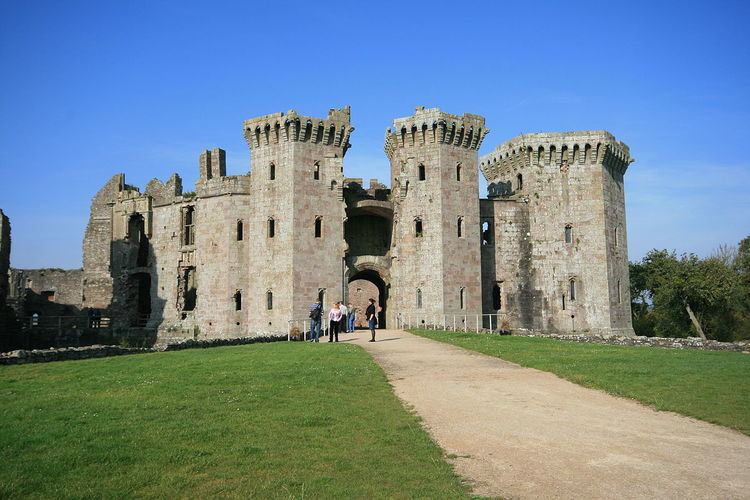Name William Thomas | ||
 | ||
Children William Herbert, 1st Earl of Pembroke Great grandchildren Elizabeth Somerset, Baroness Herbert | ||
Raglan Castle Built Fifteenth Century By Sir William ap ...
Sir William ap Thomas (died 1445) was a Welsh nobleman, politician, knight, and courtier. He was a member of the Welsh gentry family that came to be known as the Herbert family through his son William Herbert, 1st Earl of Pembroke and is an ancestor of the current Earls of Pembroke.
Contents
- Raglan Castle Built Fifteenth Century By Sir William ap
- Early Life
- The Blue Knight of Gwent
- Death and burial
- Family
- Raglan Castle
- References
Raglan manor, attained through marriage through heiress Elizabeth Bluet, was greatly expanded by William and his son, William Herbert, into the well-fortified Raglan Castle, one of the finest late medieval Welsh castles.
William served King Henry V of England during his first French campaign and in numerous subsequent capacities and was knighted in 1426.
Early Life
William ap Thomas was the son of Sir Thomas ap Gwyllym, Knt (d. 1438) of Perth Hir and Maud Morley, daughter and co-heir of Sir John Morley of Llansantffraed. In 1400 Thomas and his wife Maud inherited Llansantffraed Court, the country seat and estate of Sir John Morley. Llansantffraed Court was located approximately 2 miles west of the town of Raglan and Raglan Castle, near Clytha and Abergavenny, Wales.
The Blue Knight of Gwent
Sir William was thought by antiquarians to have fought at the battle of Battle of Agincourt and Joseph Edmondson (died 1786) states that Sir William was made knight banneret on the battlefield by Henry V. However more recent research of the rolls of those who went to France has failed to turn up his name. and primary source for Edmondson's assertion has not been found. A primary sources exist to show that he made a knight bachelor by Henry VI in 1426; and—as Octavius Morgan (died 1888) pointed out—he could not have been knighted twice. He became known to his compatriots as "Y marchog glas o Went" (the blue knight of Gwent), because of the colour of his armour. he gradually began to establish himself as a person of consequence in South Wales.
William held the following positions:
While William played an active role for the Duke of York, his sphere of influence was generally limited to South Wales.
Death and burial
William ap Thomas died in London in 1445 and his body was brought back to Wales. Gwladys and her husband William ap Thomas were patrons of Abergavenny Priory where they were both buried; their alabaster tomb and effigies can still be seen in the church of St Mary's.
Family
William married firstly in 1406 Elizabeth (died 1420), the daughter of Sir John Bluet of Raglan manor and widow of Sir James Berkeley. Elizabeth, "the lady of Raggeland", inherited Raglan Castle with her husband James Berkeley, who later died in 1405 or 1406. Before marrying Berkeley she had married and become the widow of Sir Bartholomew Picot. Elizabeth's third marriage, to William, was childless.
William married secondly heiress Gwladys ferch Dafydd Gam (died 1454), described by Welsh poet Lewys Glyn Cothi as 'The Star of Abergavenny' for her beauty. She was the daughter of Sir Dafydd Gam and the widow of Sir Roger Vaughan of Bredwardine. All three men had been part of the Welsh contingent that fought with King Henry V of England in France, including the Battle of Agincourt.
William and Gwladys had children:
Other children less consistently attributed to Gwladys and William include: Maud, Olivia, Elizabeth (who married Welsh country gentlemen, John ab Gwilym), and Thomas Herbert.
Raglan Castle
When Sir John Bloet died, Raglan manor passed to Elizabeth Bloet and her husband James Berkeley. When William's wife Elizabeth died in 1420, Elizabeth's son Lord James Berkeley inherited Raglan Manor. William resided at Raglan manor as a tenant of his stepson until 1432 when he purchased the manor from Lord Berkeley.
Grandiose expansion for defence and comfort occurred between 1432 when William ap Thomas bought the manor and 1469 when his son, Sir William Herbert, was executed. Improvements by father and son included the twin-towered gatehouse, five storied Great Tower encircled by a moat, a self-contained fortress in its own right, South Gate, Pitched Stone Court, drawbridge and portcullis.
Thomas Churchyard praised Raglan Castle in his 16th century poem, The Worthiness of Wales:
"The Earle of Penbroke that was created Earle by King Edward the four bult the Castell sumptuously at the firstDafydd Llwyd proclaimed Raglan the castle with its "hundred rooms filled with festive fare, its hundred towers, parlours and doors, its hundred heaped-up fires of long-dried fuel, its hundred chimneys for men of high degree."
